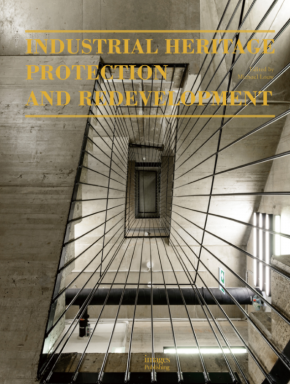Industrial Heritage Protection and Redevelopment
Industrial Heritage Protection and Redevelopment, Edited by Michael Louw, Images Publishing, 2018, 287 pages, 125 black and white and 487 colour illustrations, hardback.
For anyone involved in repurposing industrial heritage, ‘Industrial Heritage Protection and Redevelopment’ is nothing less than inspirational. It clearly illustrates the potential of redundant industrial buildings for a wide variety of uses and as a canvas for innovative intervention, while still celebrating and interpreting their original functions.
The thoughtful tone of the book is established at the very beginning where the editor (and author of the introductory chapter) provides this assessment: ‘Adaptively reused industrial buildings are layered texts that were authored by many hands over time, resulting in numerous overlapping narratives’. He acknowledges the value of tangible and intangible heritage of past industry.
A holistic and macro-level assessment to the industrial heritage and its adaptive reuse continues with an overview of all aspects of the issue at an international level. Four short but insightful essays follow by academics from Spain, the Czech Republic, and Portugal (two). They assess the value of industrial heritage, the causes and opportunities of industrial decline and, helpfully, establish roadmaps to its reuse, through planning and political policies and/or through the commitment of individual owners, communities and potential users. All are well-referenced, and capture the practical, economic, social and environmental benefits of retaining and reusing industrial heritage.
The majority of the book is dedicated to 36 case studies from around the world. Surprisingly none are from the UK – perhaps because most of the successful and worthwhile examples in the UK stick by default to the safe option of residential conversion with minimum intervention/ extensions. By contrast, the case studies illustrate the opportunity to use industrial buildings as office spaces, art spaces, commercial spaces, public buildings and mixed use ‘building complexes’, and for hotels and residences. The extent, variety, creativity and high quality of the highlighted interventions and extensions are remarkable. Each case study provides credit to the architect and client, and the date, size, location and a brief explanation of the process.
The book is lavishly illustrated with informative photographs of before and after, inside and outside, constructional detail and the buildings’ settings. Added to that are many drawings, illustrations and diagrams to show elevations, sections and floor plans of interventions and conservation. Most photographs are absent of people but this merely serves to emphasise the aesthetic quality of the converted buildings as artistic creations, rather than suggesting that they are sterile shells. It is clear that most projects have been successful in making a massive contribution to the vitality and economy of their local community and to the urban landscape.
Perhaps the biggest transformation was at The Silo in Copenhagen’s North Harbour, where the exterior of a former grain silo has been completely reclad with a ‘striking faceted galvanized steel facade’, which is articulated and punctured, in contrast to the original blank concrete facades. Nevertheless, it retains its monolithic contribution to the landscape and most of its embedded energy. Its majestic concrete interior is ‘preserved to be as raw and untouched as possible’. It is an inventive lesson for similar structures elsewhere.
This is no dry text-only tome destined for a dusty bookcase. It deserves to be on the coffee table to inspire all visitors, even by a quick glance. Behind the style, it provides substance and convincing justification for the selective and creative conservation of industrial heritage, rather than wholesale clearance and replacement with wriggly tin sheds.
This article originally appeared as ‘Canvas for intervention’ in Context 165, published by The Institute of Historic Building Conservation in August 2020. It was written by John Hinchliffe, independent heritage consultant, Hinchliffe Heritage.
--Institute of Historic Building Conservation
Related articles on Designing Buildings
- Conservation.
- Heritage.
- IHBC articles.
- Industrial Heritage Re-tooled: the TICCIH guide to industrial heritage conservation.
- Institute of Historic Building Conservation.
- Recording old industrial sites.
- The conservation challenge facing Ireland’s industrial heritage.
- The valleys - past, present, future.
IHBC NewsBlog
Old Sarum fire in listed (& disputed) WW1 Hangar - Wiltshire Council has sought legal advice after fire engulfed a listed First World War hangar that was embroiled in a lengthy planning dispute.
UK Antarctic Heritage Trust launches ‘Virtual Visit’ website area
The Trust calls on people to 'Immerse yourself in our heritage – Making Antarctica Accessible'
Southend Council pledge to force Kursaal owners to maintain building
The Council has pledged to use ‘every tool in the toolbox’ if urgent repairs are not carried out.
HE’s Research Magazine publishes a major study of the heritage of England’s suburbs
The article traces the long evolution of an internal programme to research 200 years of suburban growth
IHBC Context 183 Wellbeing and Heritage published
The issue explores issues at the intersection of heritage and wellbeing.
SAVE celebrates 50 years of campaigning 1975-2025
SAVE Britain’s Heritage has announced events across the country to celebrate bringing new life to remarkable buildings.
IHBC Annual School 2025 - Shrewsbury 12-14 June
Themed Heritage in Context – Value: Plan: Change, join in-person or online.
200th Anniversary Celebration of the Modern Railway Planned
The Stockton & Darlington Railway opened on September 27, 1825.
Competence Framework Launched for Sustainability in the Built Environment
The Construction Industry Council (CIC) and the Edge have jointly published the framework.
Historic England Launches Wellbeing Strategy for Heritage
Whether through visiting, volunteering, learning or creative practice, engaging with heritage can strengthen confidence, resilience, hope and social connections.















